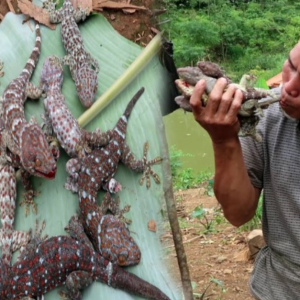This alien-looking creature is called vampire fish for a reason.

While the lamprey may look like something straight out of an Alien movie, it’s a representative of the ancient order of Petromyzontiformes. In fact, it’s one of the most primitive vertebrates alive today. Others may think that with their long, scaleless bodies, the closest relatives they have are eels, but the two aren’t actually related (although they do look similar).
The lamprey uses its jawless mouth, which is filled with circular rows of razor-sharp teeth, to attach itself onto the flesh of its hosts and suck their blood – hence the name vampire fish. As a result, the unlucky fish that the lamprey chooses as host usually die from blood loss or infection.
This parasitic fish can be found in the Black Sea, the Mediterranean sea, the Great Lakes, and in the northern and western parts of the Atlantic Ocean, for example. Interestingly enough, lampreys spend most of their life in freshwater, and a small part in saltwater. They spend the first 4-6 years of their life in a larval stage, and feed mostly on plankton. Once they metamorphize into the notorious parasitic lampreys, their kidneys go through some changes, so they can tolerate salt water. Then they can enter into oceans, seas, or large lakes where they can seek hosts to feed on. This phase usually lasts for around 18-20 months. After this, they swim up river streams (just like salmon) to spawn, which neither the male nor female lampreys survive.
During the lamprey’s feeding phase, it can kill up to 40 pounds (18,14 kilograms) of fish. Gross. In their native habitats some of their hosts have developed defensive mechanisms against lampreys, and they survive the parasitic activity. However, in waters they have invaded – most notably the Great Lakes – fish have no such defenses against them. As a result, lampreys have decimated a large number of trout and other fish populations. This has caused huge damage to the fishing industry, but most importantly to the ecosystem.

Lampreys have invaded many waters and decimated their fish populations. Image credit: USFWS
Unlike in their native waters, lampreys are the apex predators in invaded territories, and their populations are, therefore, uncontrolled. For the most part, at least. Massive efforts have been made to reduce the invasive lamprey populations by preventing the upstream movement of adults, and applying lampricide, a chemical that doesn’t affect most species, but is effective against lampreys. Even though these measures help to keep lamprey populations at bay, due to being expensive and very complicated, they don’t eradicate lampreys from invaded waters.
Despite the savage looks, lampreys don’t have a taste for humans, and aren’t known to be aggressive towards them. Humans, on the other hand, seem to have a taste for lampreys. Lamprey has been considered a delicacy since at least the ancient Romans. They especially liked the milt of the fish which they served at large feasts.

Traditional Latvian lamprey dish. Image credit: mischvalente
The popularity of lamprey dishes continued to grow in the Middle Ages – so much so, that it became known to be a food for the wealthy, and indeed, was widely eaten by the upper classes of Europe. King Henry I of England is even thought to have died because of eating too much lamprey.
Today, it’s still a very popular choice of food in the Netherlands, France, Latvia, Estonia, Finland, Sweden, Russia, Japan, and South Korea. In these countries lampreys can be bought at markets, but they can also be found frozen in supermarkets as well. Lamprey is mostly eaten grilled, smoked, or baked into a pie, but pickled lamprey recipes are also well liked.
Apparently it has a very unique taste, similar to squid. I think I’m gonna pass on that one.





